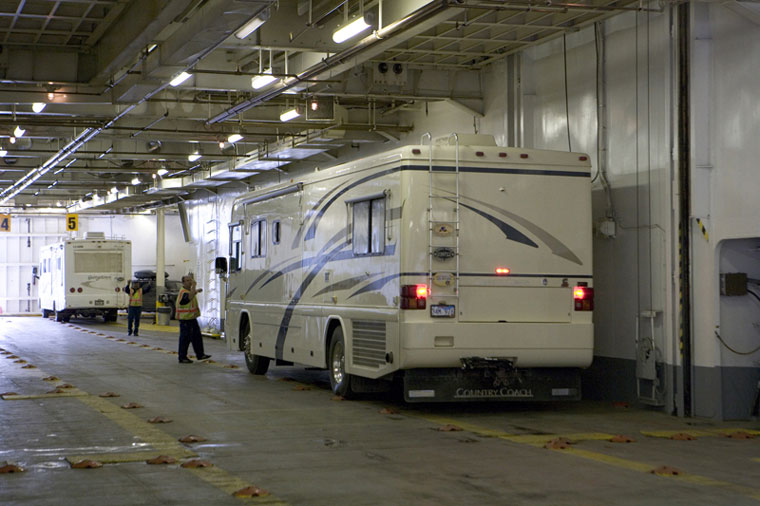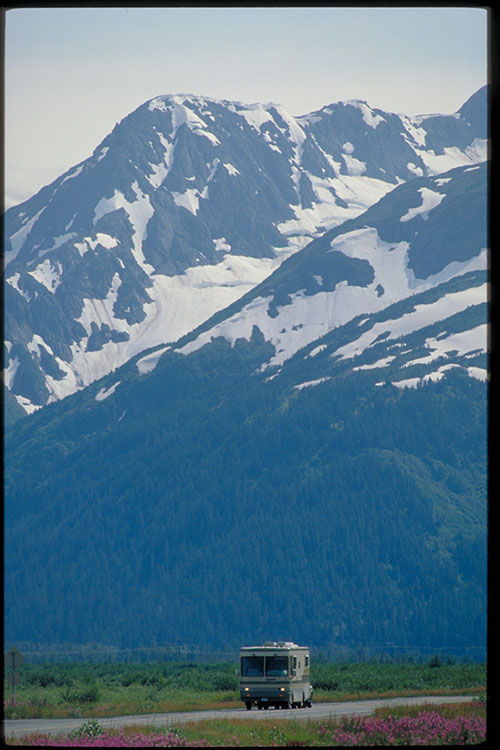RVs On the Ferry
Traveling with a RV or other large Recreational Vehicle
Planning an RV trip takes special planning and we make every effort to make certain that your needs are met. Below you will find the information needed to make ferry reservations, regulations you should know, as well as some additional useful resources.
Ferry Reservations
To make your ferry reservation we will need the length and width of your RV, including any trailers, overhangs or towed vehicles. RV's that are unable to fold mirrors to under 8' 6" wide will be charged a 25% premium. RV's 9' wide and over will be charged a 50% premium.
Drivers of vehicles with long overhangs are advised that, due to the large tidal range of Alaskan waters (up to 40 feet in some places), the angle of the transfer ramp may cause damage to undercarriage units such as holding tanks or plumbing. Vehicles longer than 25 feet may have trouble clearing the top of the car deck door at low tide. AMHS is not responsible for damage caused by the angle of the transfer ramp.
Electrical hookups for vehicle refrigeration units are not available and there is no refrigerated storage on board for passengers' commodities. Bottled gas containers must be turned off and sealed by an Alaska Marine Highway employee at the time of boarding.
The Alaska Marine Highway does not provide for loading or off-loading of vehicles. It is the shipper's responsibility to provide for the loading and off loading of vehicles.
The car deck is closed off when the ferry is underway, thus you cannot sleep in your vehicle. For more information on sleeping on the ferry see our FAQ’s and General Sailing Information. You will have access to your vehicles whenever the ferry is in port and during car deck call times, which occur up to five times a day, usually when pet owners can attend to their animals.

On the Road
Driving through Canada and Alaska is the adventure of a lifetime, but to ensure it isn’t the disaster of a lifetime you need to plan ahead. Refreshments, services, and amenities can be found at towns and small communities along your route, but with the closure of some roadhouses and seasonal closures you can find yourself traveling 100-150 miles between services on a couple of stretches of the highway. It is important to pay attention to your fuel level and fill up when you can. In addition, there are long stretches where you will be without cell phone service.
The Alaska Highway is driven year-round, but expect the most traffic from May to September. During June and July you will find the most daylight and the best chance for sunshine. In August summer fades into fall and by September the temperatures can dip below freezing at night. As always in Alaska and the in the mountain passes weather can be unpredictable.
The road conditions range from poor to excellent, the highway is paved but you will still encounter gravel breaks that vary from a few feet long to several miles. Upkeep of the highway occurs every summer creating brief delays. A variety of vehicles tackle the highway each year, as long as your vehicle is in good working condition with good tires and you carry a spare you should have no cause for concern.
Border Information
For border information please see FAQ page.
Useful Resources
Weather and Road Conditions:
http://511.alaska.gov/alaska511
RV Parks and General Planning:
http://dnr.alaska.gov/parks
http://www.travelalaska.com
http://www.blm.gov
http://www.nps.gov/akso/index.cfm
http://milepost.com
Emergency Equipment for your Vehicle
- Flares and reflectors
- First aid kit with knife and pocket mask
- Multi-purpose dry chemical fire extinguisher
- Tow cable (at least 20 feet)
- Spare tire - inflated to proper pressure
- Tool kit (pliers, screwdriver, wrenches)
- Flashlight and spare batteries
- Maps, pencil and paper
- Jumper cables
- Matches and candles
- Containers for liquids
- Facial and toilet tissue; Paper towels
- Supply of non-perishable foods
- Transistor radio and extra battery
- Full tank of gasoline - always drive on upper half
- Come-along
- Nylon rope (at least 20 feet)
- Insect repellent
Additional Equipment for Winter Driving
- Chains
- Shovel
- Ice Scraper
- Sack of sand
- Blanket; sleeping bag
- Extra warm clothing

